About Us
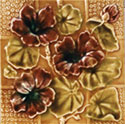 Skellramics was founded in 1990 by Kelly and Natasha, a multi-disciplinary team, working in a variety of materials, specializing in the artful execution of functional large scale spaces made up of, evocative custom-crafted murals and creative architectural tile installations as well as, fine- art ceramic pieces. Several museums include Skellramics pieces in their collections including, San Francisco's Museum Of Natural History, San Diego's Museum of Man, and The Children's Museum in Indianapolis.
Skellramics was founded in 1990 by Kelly and Natasha, a multi-disciplinary team, working in a variety of materials, specializing in the artful execution of functional large scale spaces made up of, evocative custom-crafted murals and creative architectural tile installations as well as, fine- art ceramic pieces. Several museums include Skellramics pieces in their collections including, San Francisco's Museum Of Natural History, San Diego's Museum of Man, and The Children's Museum in Indianapolis.
Skellramics' tile murals and custom tile work in unique, intricate designs and bright colors also have the distinction of being architecturally sound and durable enough to weather decades of use. The theme-intense installations include work done in private homes as well as high-traffic commercial locations, including custom work for Wolfgang Puck's Granita Restaurant in Malibu, California (project included hand-crafted tile railings, custom column mosaic, and vestibule work in a seascape palette of artisan glazes) and interior custom tile pieces for many locations of Wolfgang Puck's Pizza restaurants. The team's work also appears prominently, in the custom mosaic exterior walls of the store front, as well as, a section of the interior flooring of the former Handmade Galleries in Sherman Oaks on Ventura Blvd. Custom work in private homes (poolside, kitchen and bathroom installations, unique art pieces, carrying out a number of themes from Art Nouveau to futuristic) have been commissioned and collected by many celebrities.
History of Tile
The latin word "tegula" and its french derivative "tuile" mean quite precisely a roof tile of baked clay. The english word "tile" is less precise, as since can be used as any kind of earthenware slab applied to any surface of a building. The word "ceramic" comes from the greek word 'keramos' meaning pottery, it is related to an old sanskrit meaning "to burn" but was mostly used to mean "burnt stuff".
Origin of tile
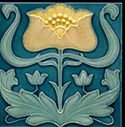 Historically, people have desired to create living spaces that were beautiful, durable, and user friendly, with that in mind, ceramic tile has been made for thousands of years. Beautiful tiled surfaces have been found in the oldest pyramids, the ruins of Babylon, and ancient ruins of greek cities. Decorative tile was invented in the near east, where it has enjoyed a longer popularity and assumed a greater variety of design than anywhere else in the world. During the Islamic period, many methods of tile decorations were brought to perfection in Persia. In Europe, decorated tiles did not come into general use outside Spain until the second half of the 12th century. The tile mosaics of Spain and Portugal, the maiolica floor tiles of Rennaisance Italy, the faiences of Antwerp, the development of tile iconography in England and in the Netherlands, and the tiles of Germany all are prominent landmarks in the history of ceramic tile.
Historically, people have desired to create living spaces that were beautiful, durable, and user friendly, with that in mind, ceramic tile has been made for thousands of years. Beautiful tiled surfaces have been found in the oldest pyramids, the ruins of Babylon, and ancient ruins of greek cities. Decorative tile was invented in the near east, where it has enjoyed a longer popularity and assumed a greater variety of design than anywhere else in the world. During the Islamic period, many methods of tile decorations were brought to perfection in Persia. In Europe, decorated tiles did not come into general use outside Spain until the second half of the 12th century. The tile mosaics of Spain and Portugal, the maiolica floor tiles of Rennaisance Italy, the faiences of Antwerp, the development of tile iconography in England and in the Netherlands, and the tiles of Germany all are prominent landmarks in the history of ceramic tile.
Ceramic technique
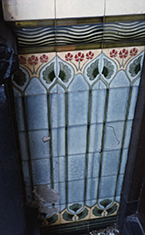 The technique of tile and its secrets of trade were safely guarded and orally handed from family membes to their children and master to student; so rarely have designs, patterns and details of technique been documented in the past. Each individual tile was hand-formed and hand-glazed, making each tile art in its own right.
The technique of tile and its secrets of trade were safely guarded and orally handed from family membes to their children and master to student; so rarely have designs, patterns and details of technique been documented in the past. Each individual tile was hand-formed and hand-glazed, making each tile art in its own right.
Ceramic tile is made of clay. Ttiles were made by hand. In early days clay bricks - made by flattening the clay and cutting pieces into shape - were dried beneath the sun or baked. Later, the only mechanical aid was a wooden mould carved in relief, which indented as a pattern on the clay slab. The slab was dried and the impression filled with clay, which after further drying was shaved flat. After the formation of the tile body, ceramic tiles go through a firing process in a kiln under very high heat to harden the tile and to create the surface glaze. Hhistorically, unglazed tile was fired once. Glazed tile was fired twice. Tthe first firing forms a tile body called "bisque". Bisque firing had the highest temperature at 1060 C that fixed the tiles for size and shape. Aafter glazing the tiles second time, they are fired at about 1020 - 1240 C. The modern tile industry has advanced by reviving the lost art of encaustic tile-making. The industry was further revolutionized in the 1840s by the 'dust-pressing' method which consisted of compressing nearly dry clay between two metal dies. dust-pressing replaced tile-making by hand with wet clay, and facilitated mechanization of the tile-making industry.
Decorative techniques
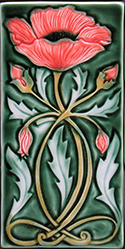 UNGLAZED:
UNGLAZED:
Color range in unglazed tiles is limited to the natural color of the clay, ranging from a light sand to a red brick.
PLAIN GLAZES:
White lead, flint, china stone and china clay were ground to form a glaze. a clear glaze brought out the natural body colour and might be applied over any coloured decoration. Glazed tiles are decorated with natural and artificially colors. Palette of colors consists of glaze and underglaze colors. The first glazes were blue in color and were made from copper, also turquoise and light green glaze were popular colors. Ground metal oxides could be added to give different colours.
ENCAUSTIC OR INLAID:
This method was to fill the matrix of a stamped tile with white pipeclay before it was glazed and fired. The two sections fusing during firing.
MOSAIC:
Tiles in broken form or small glass or tile installed to create a pattern or design. Very effective in reflecting light. History of mosaic dates back to over 5 thousand years old.
HANDPAINTING:
Artist painted freely onto a plain surface tile. Usually requring underglaze to be painted two to three layers with brush, then after first firing, decorative and finishing glazed are applied. After the second firing, tile is ready for installation.
CARVED AND MODELLED TILES:
Each piece is individually carved in relief or modelled in clay, The pattern could be engraved in outline on the surface of the tile or the design carved in relief or counter-relief on a wood-block which was then pressed into the tile.
SGRAFFITO:
An early form of decoration, the tile body is covered with coats of slip that is scratched off to produce the design.
LUSTRE PAINTING:
Metallic lustre of glazed ceramics is a very special type of decoration. It can be red, brown, ochre yellow or green in scattered light and shows, in specular reflection, coloured metallic reflections (blue, yellow, orange, rose…). metallic copper and silver colloids suspensed in glazes compose lustre decoration.
Slip is trailed onto the surface of the tile to make raised lines separating the areas where different colour is wanted. Coloured glazes were then applied. This technique was used for art nouveau tiles in Europe.
About glazing
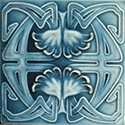 A glaze is a smooth, glassy coating applied to ceramic objects in order to add color and decoration to the surface or to vary its texture. The glaze forms a hard, nonporous surface that is easily cleaned.
A glaze is a smooth, glassy coating applied to ceramic objects in order to add color and decoration to the surface or to vary its texture. The glaze forms a hard, nonporous surface that is easily cleaned.
Glazes are usually made from powdered glass combined with colored oxides of such elements as cobalt, chrome, manganese, or nickel. The mixture of powders is suspended in water and applied to the ceramic surface by brushing several coats of the glaze. The glaze is then dried and fixed onto the ceramic surface by firing. During firing, the glass softens and flows over the ceramic surface to a greater or lesser extent, and reacts with the ceramic substrate to form a strong, adherent bond to it. Various components such as alkali oxide, borates, and lead oxide can be added to the glaze to make it soften at a lower temperature, so that it flows more easily during firing and smooths out roughness and defects in the ceramic surface.
A second firing is necessary to melt and bond the second coat of glaze to the object. Two firings make possible a greater range of colors and textures.
Often fine crystals grow in the glaze, making it more translucent or opaque. Crystals also give a dull, or mat, surface finish. The crystals nucleate and grow in the glassy glaze in much the same way as they do in glass ceramics. Crystal growth can be encouraged by heating the fired glaze for a time at a temperature somewhat below the firing temperature.
Colors in glazes are controlled by adding coloring agents to the glassy components of the glaze. A wide variety of colors are possible, depending upon the agent added, the base composition of the glaze, and the state of oxidation in the kiln. Temperature fluctuations in the atmosphere, and other anomalies will cause variations in the glaze colors from one batch to another and even in the same firing depending on where the ceramic pieces are located relative to the hottest and coolest areas of the kiln.